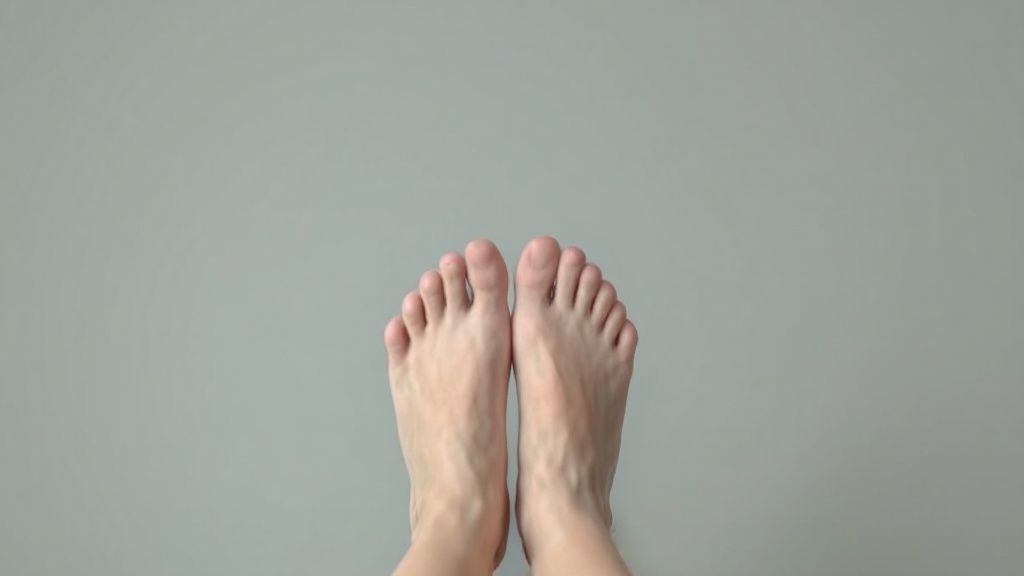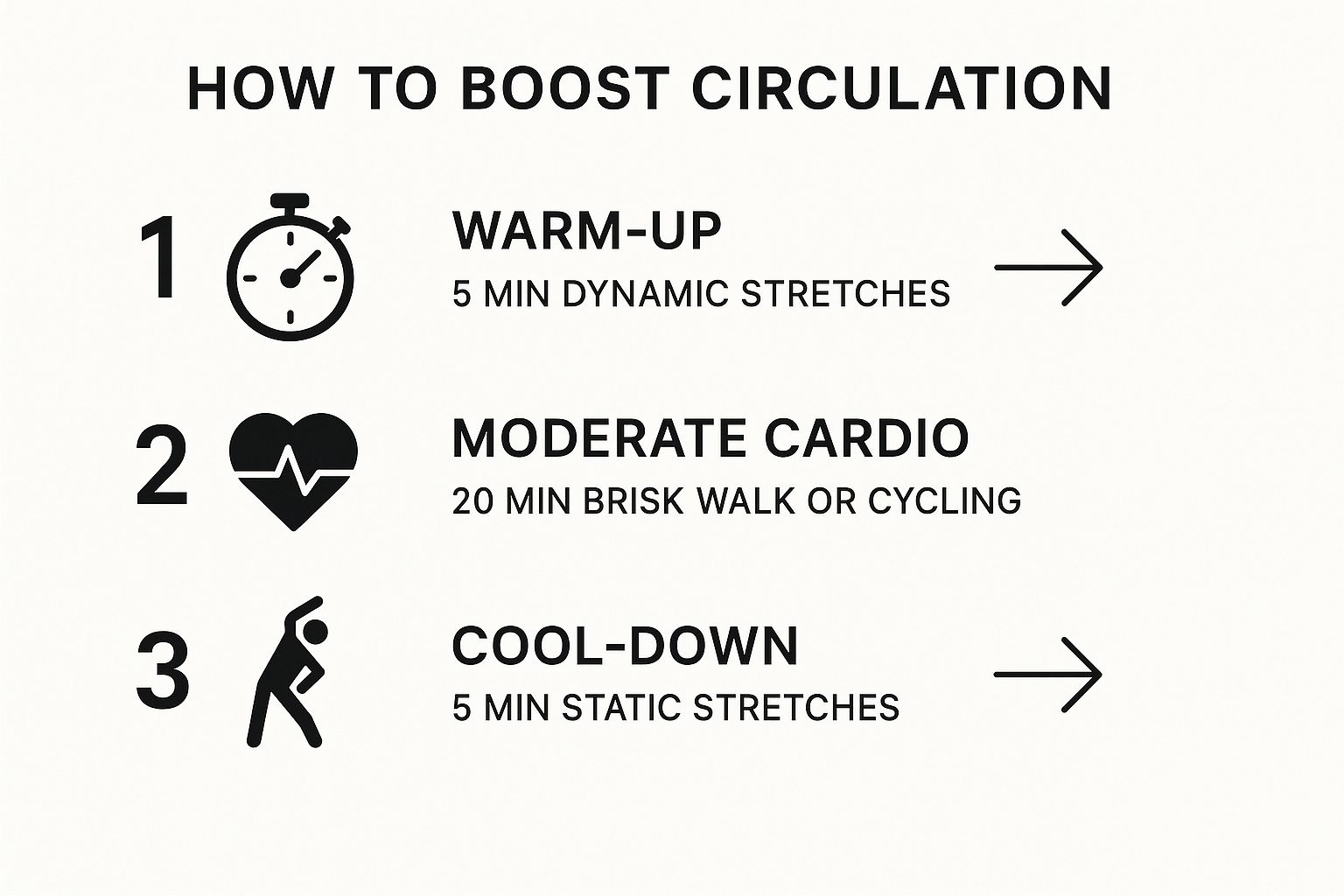If you've been searching for how to improve poor circulation, you've probably realized there's no single magic bullet. And you're right. The real solution is a holistic one that weaves together smarter choices in your daily diet, movement, and overall lifestyle. We're talking about tangible strategies like adding more nitrate-rich foods, getting your heart pumping …
If you've been searching for how to improve poor circulation, you've probably realized there's no single magic bullet. And you're right. The real solution is a holistic one that weaves together smarter choices in your daily diet, movement, and overall lifestyle. We're talking about tangible strategies like adding more nitrate-rich foods, getting your heart pumping with regular cardio, and finally ditching habits like smoking.
Your Practical Guide to Boosting Circulation

Poor circulation often shows up in ways you might brush off at first—hands and feet that are always cold, nagging fatigue, or even thinning hair. These are all subtle nudges from your body that it's struggling to deliver oxygen-rich blood where it's needed most. This delivery system is crucial for everything from healing a simple cut to maintaining brain function and heart health.
Imagine your circulatory system as the body's superhighway. When there's a traffic jam, every destination suffers. The great thing is, you have a lot of power to clear those roadblocks and get things flowing smoothly again. It's all about creating an internal environment that supports and enhances blood flow.
The Pillars of Enhanced Blood Flow
To make a real, lasting impact, we need to focus on the fundamental pillars of a healthy circulatory system. These aren't about extreme measures; they're about making consistent, manageable adjustments that compound over time.
- Nourishing Your Body: We'll dive into specific foods that act as natural vasodilators—basically, they help relax and open up your blood vessels to improve flow.
- Adopting Smart Movement: This isn't about running marathons (unless you want to!). It's about finding consistent activity that strengthens your heart and keeps your blood moving efficiently.
- Leveraging Lifestyle Habits: You’d be surprised how much simple tweaks, like managing stress or just standing up more often, can affect your circulation.
- Exploring Targeted Therapies: For those who want to take it a step further, specialized options like infrared saunas can offer a direct boost to circulatory health.
Think of this guide as your roadmap. Each strategy builds on the others, creating a powerful, cumulative effect that supports not just your circulation, but your overall well-being. For a deeper dive, there are some excellent resources on natural ways to improve circulation.
To give you a quick snapshot of what we'll be covering, here’s a simple table that breaks down the core strategies.
Core Strategies for Boosting Circulation
This table offers a quick-glance summary of the key methods discussed in this guide for improving blood flow. It's a great reference for what works, why it's effective, and how you can start today.
| Strategy | Primary Benefit | Simple Starting Action |
|---|---|---|
| Circulation-Boosting Diet | Widens blood vessels and reduces inflammation. | Add a handful of spinach to your next meal. |
| Regular Physical Activity | Strengthens the heart and improves oxygen delivery. | Take a brisk 10-minute walk during your lunch break. |
| Positive Lifestyle Habits | Reduces vessel constriction and plaque buildup. | Practice 5 minutes of deep breathing to manage stress. |
| Targeted Therapies | Directly stimulates blood flow and vessel dilation. | Research infrared sauna benefits for microcirculation. |
With these pillars in mind, you have a clear framework for making meaningful changes that will get your blood flowing freely and efficiently.
Eating for Better Blood Flow

You've heard "you are what you eat" a million times, but it’s especially true for your circulatory health. This isn't about vague, restrictive dieting. It’s about being smart and strategic, adding specific foods to your plate that contain powerful compounds to get your blood moving like it should.
By intentionally choosing vibrant, nutrient-dense foods, you're essentially giving your body the raw materials it needs to support its own natural processes. When I talk with clients about improving circulation, diet is always one of the first and most effective places we start.
Power Up with Nitrates and Flavonoids
So, where do we begin? Let's talk about nitrates. Certain vegetables are packed with them, and your body cleverly converts these nitrates into nitric oxide. Think of nitric oxide as a natural vasodilator—it tells your blood vessels to relax and widen, which makes it much easier for blood to flow through. It's like turning a congested one-lane road into a three-lane highway.
Here are a few of my go-to sources:
- Beets: Whether you roast them, juice them, or toss them in a salad, beets are a true nitrate powerhouse.
- Spinach: So easy to work with. I throw it in everything from morning smoothies to simple sautés.
- Arugula: The peppery kick is fantastic, and it makes an excellent base for a circulation-friendly salad.
At the same time, we want to bring in flavonoids. These are the compounds that give fruits and vegetables their brilliant colors, and they do wonders for strengthening the walls of your blood vessels. Berries—blueberries, strawberries, raspberries—are loaded with these protective antioxidants, helping keep your vessels flexible and resilient.
A simple, real-world way to combine these is a morning smoothie with a cup of spinach, a handful of mixed berries, and a small, cooked beet. It’s a delicious cocktail for your circulatory system. For a deeper dive, our guide on the best foods for circulation has even more ideas.
Embrace Healthy Fats and Hydration
The conversation around fats has changed, and for good reason. Not all fats are bad for you. In fact, Omega-3 fatty acids are incredible for fighting inflammation. Chronic inflammation is a major culprit behind damaged blood vessel linings and poor circulation, so keeping it in check is absolutely essential.
Key Takeaway: Try to get fatty fish like salmon, mackerel, or sardines on your plate two to three times a week. This simple habit can make a real difference in reducing inflammation and supporting your heart. A piece of baked salmon next to some steamed spinach is a perfect one-two punch for better blood flow.
And it’s not just about fish. Other healthy fats play a role, too. For instance, many people are now using olive oil to support healthy blood pressure and heart health, which is another cornerstone of a healthy circulatory system.
Finally, let’s not forget the basics: water. Your blood is more than 50% water. When you get dehydrated, your blood volume actually drops, making it thicker and tougher for your heart to pump. This directly slows down circulation. Simply sipping water consistently throughout the day is one of the easiest and most effective things you can do to keep things flowing smoothly.
Activating Your Circulation with Movement
If there’s one non-negotiable for anyone looking to boost their circulation, it's movement. Think of exercise as the most powerful, natural pump you have for your entire vascular system. This isn't about pushing yourself through grueling, high-intensity workouts, but rather weaving consistent, intentional movement into your day to get your blood flowing freely.
Every time you move, you signal your heart to work a little harder, which pushes more oxygen-rich blood out to your muscles and organs. Over time, this strengthens the heart muscle, making it a much more efficient pump. At the same time, your muscles contract and relax, squeezing the veins around them and literally helping to push blood back up toward your heart.
Why Cardio Is King for Your Arteries
Cardiovascular exercise is really the cornerstone of a healthy circulatory system. Any activity that gets your heart rate up for a sustained period—even a brisk walk—trains your heart to pump more blood with less effort. That improved efficiency is a genuine game-changer for your entire body.
When you do cardio, your blood vessels also get a workout. They actually learn to dilate more easily to handle the increased blood flow. This helps them stay flexible and prevents the kind of stiffness that can contribute to high blood pressure down the road.
Here’s a simple visual guide that lays out a balanced movement routine, from warm-up to cool-down, designed specifically to boost your circulation.

As you can see, just 30 minutes of structured activity, including a proper warm-up and cool-down, can create a fantastic circulatory boost.
Not all exercise impacts your system in the same way. Different types of movement offer unique benefits for getting your blood flowing. I've put together a quick comparison to show how each one contributes.
Comparing Exercises for Enhanced Circulation
| Exercise Type | Primary Circulatory Benefit | Example Activities |
|---|---|---|
| Cardiovascular (Aerobic) | Strengthens the heart muscle, making it a more efficient pump. Improves artery flexibility. | Brisk walking, jogging, cycling, swimming, dancing |
| Resistance (Strength) Training | Builds skeletal muscle, which acts as a "secondary pump" to help push blood back to the heart. | Weightlifting, bodyweight exercises (squats, push-ups), resistance bands |
| Flexibility & Mobility | Reduces muscle tension that can constrict blood vessels. May improve arterial flexibility. | Yoga, Tai Chi, dynamic stretching, daily static stretches |
Each of these categories plays a vital role. Cardio is your primary engine, resistance training builds the support system, and flexibility work keeps all the pathways open and clear. A truly effective plan incorporates a bit of all three.
Building Your Secondary Pump with Resistance Training
While cardio strengthens your heart, resistance training builds a powerful secondary circulatory system. Your skeletal muscles are critical for what’s called venous return—the process of getting blood from your arms and legs back to your heart. When you build more muscle, you're essentially creating stronger "pumps" all over your body.
Every time you do a squat, lift a weight, or perform a push-up, your muscles contract and squeeze the nearby veins. This action propels deoxygenated blood upward, fighting against gravity. It’s especially important for circulation in your legs, where blood has the longest and toughest journey back to the heart.
A Practical Tip: You don't need a gym membership to get started. Simple bodyweight exercises are incredibly effective. I often tell my clients to try doing 20 calf raises while waiting for their coffee to brew. This small action directly engages the calf muscles, a common bottleneck for poor circulation.
The Gentle Power of Flexibility and Stretching
It’s easy to overlook stretching, but its benefits for blood flow are huge. Gentle practices like yoga, tai chi, and even just a few simple daily stretches improve the flexibility of not just your muscles, but your arteries as well. When your arteries are flexible, they can expand and contract more easily, which is key for healthy blood pressure and efficient flow.
Stretching also works wonders for relieving muscle tension. When your muscles are chronically tight, they can physically clamp down on the blood vessels running through them, creating a traffic jam for your circulation. A few minutes of stretching each day can release that tension and open everything back up.
Try adding these simple movements into your routine:
- Ankle Rotations: While sitting at your desk or watching TV, slowly rotate your ankles in circles, 10 times in each direction.
- Leg Lifts: Lie on your back and gently lift one leg at a time toward the ceiling. Hold for 15-20 seconds to feel a gentle stretch in your hamstring.
- Cat-Cow Stretch: On your hands and knees, gently arch and round your back. This is fantastic for improving blood flow along the spine and to your core organs.
These small, consistent movements really do compound over time. They can make a noticeable difference in how you feel and are a crucial piece of the puzzle when it comes to improving poor circulation for good.
Targeted Therapies for Enhanced Blood Flow

While a healthy diet and regular movement are the cornerstones of great circulation, sometimes your body just needs an extra nudge. This is where specialized therapies come in. They act as powerful complements to your daily habits, offering targeted support to get your blood moving more freely.
Think of these therapies not as a replacement for the fundamentals, but as strategic tools to accelerate your progress. They can be especially helpful if you’re still struggling with things like cold hands and feet or muscle stiffness despite making other positive changes.
Harnessing Heat with Infrared Saunas
Infrared saunas are a whole different experience from the traditional saunas you might be used to. Instead of just heating the air around you, they use infrared light to penetrate deep into your body’s tissues, raising your core temperature from the inside out.
This deep, gentle heat has a pretty incredible effect on your circulatory system. It encourages your blood vessels to dilate (widen), which is a process known as vasodilation. This widening allows blood to flow more easily, especially to your extremities, delivering a fresh supply of oxygen and nutrients where they're needed most.
Many of my clients report feeling less stiff and more energized after a consistent infrared sauna routine. You can dive deeper into the full range of infrared sauna therapy benefits to see how it might fit into your wellness plan.
The Mechanical Assist of Compression Therapy
For a more hands-on approach, compression therapy works wonders, especially for the lower body. This involves wearing specially designed garments—like socks, stockings, or sleeves—that apply a gentle, graduated pressure to your limbs.
This pressure essentially gives your veins a helping hand. It mechanically squeezes the tissues to help push blood from your legs and feet back up toward your heart, working against the pull of gravity. It's a game-changer for anyone who spends long hours sitting at a desk or standing on their feet all day.
A typical session in an infrared sauna might last 20-30 minutes, while compression socks can be worn for hours at a time. Both are fantastic ways to give your circulatory system the targeted support it needs to thrive.
Who Can Benefit Most from These Therapies?
While almost anyone can enjoy these therapies, some people will find them particularly helpful. See if you fall into one of these groups:
- People with Sedentary Jobs: If you sit or stand all day, blood has a tendency to pool in your legs. Both infrared saunas and compression can help counteract that stagnation.
- Athletes and Active Individuals: Looking for better recovery? The enhanced blood flow from these therapies helps deliver more oxygen to tired muscles and efficiently clear out metabolic waste like lactic acid.
- Those with Persistently Cold Hands and Feet: If you're always reaching for gloves or extra socks, the improved microcirculation from infrared heat can bring welcome, lasting warmth.
Of course, before starting any new therapy, it's always wise to have a quick chat with your healthcare provider to make sure it's a good fit for your unique health situation.
Making Daily Habits Work for Your Circulation
Your daily routine is a powerful force, shaping your circulatory health in ways you might not even realize. It's not just about what you do at the gym or in the kitchen. Things like stress, sitting at a desk all day, and smoking have a direct, and often negative, impact on how well your blood flows.
The good news is that you don't need a massive overhaul. Small, consistent tweaks to your daily life can create an environment where your circulatory system doesn't just survive—it thrives. It’s all about removing the roadblocks that tighten your vessels and choosing habits that encourage easy, efficient blood flow.
Break Up with Your Chair
Let's be honest, sitting for eight hours a day at a desk has become the norm, but it's a huge obstacle for good circulation. When you stay put for that long, blood flow to your legs can slow to a crawl, leading to that heavy, stagnant feeling. The trick is to interrupt those long periods of sitting with simple, frequent movement.
This isn't about running a marathon on your lunch break. Think small and consistent.
- Become a "Stand-Up" Person: Set a recurring alarm on your phone or watch. When it goes off every hour, just stand up and stretch for 60 seconds. It's a tiny change that makes a big difference.
- Try Some "Stealth" Exercises: While you're on a call, do some seated leg lifts. Just extend one leg straight out, hold it for a few beats, and then switch. It keeps things moving without anyone knowing.
- Walk and Talk: Instead of sending that one-line email to a coworker in the next aisle, get up and walk over. Those little trips really do add up.
Keep Calm and Let Your Arteries Relax
Chronic stress is like a silent saboteur for your circulation. When you’re constantly on edge, your body is flooded with hormones like cortisol. This puts your arteries in a constant state of tension, causing them to tighten up. Over the long haul, this can lead to serious inflammation and damage the delicate lining of your blood vessels.
This is where simple mindfulness practices come in. Calming your nervous system is one of the best ways to help your blood vessels physically relax.
A Quick Reset: Try this breathing exercise right now. Inhale slowly through your nose for a count of four. Hold that breath for another four counts. Then, exhale slowly through your mouth for a count of six. Do this just five times, and you’ll feel an immediate shift.
That constant stress-induced inflammation is a major player in vascular issues. We go deep into this topic in our guide on how to reduce chronic inflammation.
Why Quitting Smoking Is a Game-Changer
If you're a smoker, stopping is hands-down the most impactful thing you can do for your circulation. Smoking is a triple threat: it damages the artery linings, makes your blood thick and sticky (which is a recipe for clots), and physically constricts your blood vessels. It’s a full-on assault that chokes off blood flow everywhere in your body.
But here’s the amazing part: your body starts repairing itself almost as soon as you quit. The benefits are immediate and profound.
It’s fascinating how circulation works on both a micro and macro level. On a global scale, huge systems like the Atlantic Meridional Overturning Circulation (AMOC)—a massive ocean current—are vital for the planet's health. Scientists have found it has slowed by an estimated 15% in recent decades, which you can read about in this full report on Global Trends. Just like that current is crucial for the Earth, your own circulatory system is absolutely essential for your personal well-being.
Got Questions About Improving Your Circulation? We’ve Got Answers.
Whenever you start making big, positive changes to your health—like focusing on your circulation—questions are bound to pop up. It’s completely normal to wonder how long it will take to feel a difference, whether supplements can give you a boost, or when it’s time to call in a professional.
Let’s walk through some of the questions I hear most often from people just starting out. Getting clear, straightforward answers can help you stay on track and feel confident in the process.
How Long Until I Actually Notice a Difference?
This is the big one, isn't it? Everyone wants to know when their hard work will pay off. The honest answer is: it really depends on the person.
You might start noticing small, encouraging signs—like your hands and feet not feeling so icy—within a few weeks. That’s a great motivator! But for the deeper, more significant changes in your vascular health to take root, you’ll need to be patient.
Generally, you’re looking at three to six months of consistent effort to see substantial improvements. Your starting health, your age, and most importantly, how dedicated you are to the new habits all factor in. Think of this less as a race and more as a long-term commitment to your body.
Are There Any Supplements That Genuinely Help Blood Flow?
It's easy to get drawn in by the promise of a quick fix in a bottle. You'll see supplements like beetroot extract, ginkgo biloba, and L-arginine all over the internet, often touted for their ability to support circulation.
And while some of them do have promising research behind them, it’s critical to see them for what they are: a supporting cast. They are not, and never will be, a substitute for a healthy diet and moving your body regularly.
A quick but important word of caution: Always, always talk to your doctor before starting a new supplement. They can have surprising interactions with medications you’re already on or might not be right for your specific health situation. Getting a professional opinion first is just smart, safe health practice.
When Is It Time to See a Doctor?
The lifestyle changes we've covered are fantastic for managing milder circulation issues. But sometimes, your body sends up a red flag that you absolutely shouldn't ignore. If your symptoms are severe or come on suddenly, it's time to make a doctor's appointment right away.
Be on high alert for these warning signs:
- Intense, unexplained pain, especially in your limbs.
- Noticeable skin discoloration, like a bluish or stark white patch.
- Sudden swelling that only affects one leg.
- Sores or ulcers on your legs or feet that just won't heal.
These could point to something more serious that needs a medical diagnosis, like peripheral artery disease (PAD) or even a blood clot (DVT). These conditions require a doctor's care, so don't wait.
At Healing Waters Wellness Center, we offer specialized therapies like infrared saunas that complement your efforts to boost circulation. Learn how our holistic treatments can support your journey to better health.






